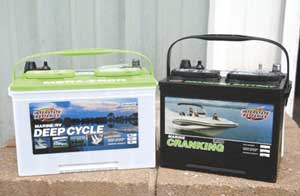
A friend just installed a new 24-volt trolling motor and was disappointed when it ran only about three hours before the batteries died. He asked me to look at his new system, and I found several common ailments. First, his two batteries were distant relatives instead of identical twins. He had a cranking battery and a deep-cycle battery wired in series to power the motor.
Any time multiple batteries are used in a single circuit, they should be as close to identical as possible. Batteries of the same brand, size, model and age work best together whether they are wired in parallel or series, and whether they power a trolling motor or crank an engine.
Cranking batteries are not designed for deep-cycle use. They can’t supply trolling motor power for as long as deep-cycle batteries, and they can be severely damaged by just a few deep discharge/recharge cycles.
Batteries try to equalize when connected in the same circuit, and when one becomes weaker, it pulls the stronger battery down to its level. This electrical tug-of-war wastes power that should be available for use.
The batteries in my buddy’s boat were the smallest spiral-cell AGM batteries available, and he was running his motor at 80 percent of maximum thrust.
There is nothing wrong with spiral-cell batteries, but as with other types, the largest models offer longer running time than the smallest.
Look at the Reserve Capacity rating when you shop for batteries. The RC number tells you how many minutes a battery is rated to carry a 25-amp load without dropping below 1.75 volts per cell, and the bigger the number the better. Few marine batteries still carry the old amp-hour rating, but if you are more comfortable using it, you can convert the RC rating to an estimated amp-hour rating with the formula (Reserve Capacity x 0.6 = Amp Hours).
The trolling motor wiring in my friend’s boat looked a bit small, and I asked what size he used between the trolling-motor plug receptacle and the batteries. He used 8-gauge wire, which is O.K. for the 4-foot run to his bow battery compartment but would be too light for a run to a battery compartment back near the stern.
Back in the days when trolling motors only produced 25 pounds of thrust, a 20-foot run of 10-gauge wire found in some bass boats (instead of the recommended 6-gauge wire) would reduce thrust by 6 pounds. I use 6-gauge wire for all trolling motor wiring including the jumper wires between batteries in 24- and 36-volt systems.
The owner of the local trolling motor repair shop was also on hand as all this took place, and when my friend said he was trolling crankbaits with his electric motor for the three hours that the batteries lasted, he pointed out another important fact. While we call the electric motors mounted on the bows and transoms of our boats trolling motors, motor manufacturers say that’s a misnomer. They are really boat positioning motors designed to turn, hold and maneuver our boats as we fish from them. They really aren’t designed for constant trolling.
The repair shop owner then asked us if we could remember the last time we removed the props from our motors to check for fishing line around the prop shafts. When we hesitated, he said that the right answer was, “After my last fishing trip.”
The first symptom of this problem is usually a dead motor. The line works its way toward the motor, cuts through the prop shaft seals and allows water into the motor housing. The only fix is an expensive motor rebuild.
He also suggested taking a close look at the props while they were off the motor because chipped, broken or otherwise unbalanced props can cause motor-damaging vibration.
Pay attention to these details, and your electric “positioning” motor should perform flawlessly and not provide any wallet-lightening surprises.


